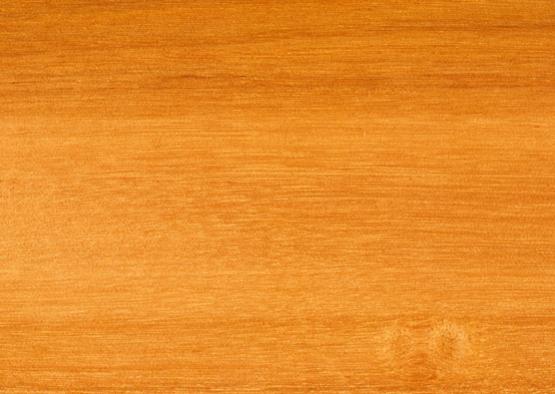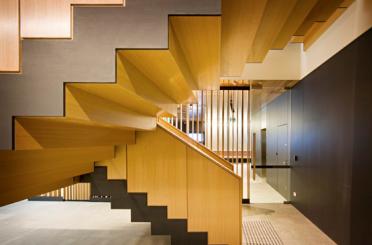Brush box is a medium to large sized Australian hardwood that grows along the edges of the rainforest areas of New South Wales and Queensland. It is used for a variety of applications including flooring, cladding and bridge decking.
Pink Box, Scrub Box, Tristania conferta
Lophostemon confertus

Brush box is a medium to large sized Australian hardwood that occurs along the edges of the rainforest areas of the central coast of New South Wales to Bowen in Queensland.
Its heartwood can vary in appearance, from a greyish pink through to a reddish brown, while the sapwood is usually paler in colour. Brush box has a fine and even texture with an interlocking grain – a feature that is appealing for appearance-based applications such as timber flooring, but can cause significant distortion during drying.
Brush box has a poor workability in part due to its density, interlocked grain and the presence of silica. It does however provide good resistance to wear and splintering. The natural waxiness may cause problems with some adhesives but provides a very good base for paints and stains. Brush box is not suitable for steam bending.
Brush box is used for a variety of applications including flooring, cladding, paneling and some structural applications. It is generally available for use in New South Wales and Queensland.
Shrinkage
| Very Low | Low | Medium | High | Very High | |
|---|---|---|---|---|---|

|

|

|
|||
Tangential : |
9.70%
|
||||
Radial : |
4.40%
|
||||
Unit Movement Tangential: |
0.38%
|
||||
Unit Movement Radial: |
0.24%
|
Strength Group

Very High |
High |
Reasonably High |
Medium High |
Medium |
Reasonably Low |
Low |
Very Low |
||
Unseasoned: |
S1 |
S2 |
S3 |
S4 |
S5 |
S6 |
S7 |
S8 |
|
|---|---|---|---|---|---|---|---|---|---|
 |
|||||||||
Seasoned: |
SD1 |
SD2 |
SD3 |
SD4 |
SD5 |
SD6 |
SD7 |
SD8 |
|
 |
Stress Grade

| Structural No. 1 |
Structural No. 2 |
Structural No. 3 |
Structural No. 4 |
Structural No. 5 |
|
Unseasoned: |
F17 |
F14 |
F11 |
F8 |
F7 |
Seasoned: |
F27 |
F22 |
F17 |
F14 |
F11 |
Density per Standard

Seasoned: |
890kg/m3
|
|---|---|
Unseasoned: |
1190kg/m3
|
Joint Group

Very High |
High |
Reasonably High |
Medium |
Low |
Very Low |
|
Unseasoned: |
J1 |
J2 |
J3 |
J4 |
J5 |
J6 |
|---|---|---|---|---|---|---|
 |
||||||
Seasoned: |
JD1 |
JD2 |
JD3 |
JD4 |
JD5 |
JD6 |
 |
Colour

| White, yellow, pale straw to light brown | Pink to pink brown | Light to dark red | Brown, chocolate, mottled or streaky | |
 |
||||
Mechanical Properties
Modulus of Rupture - Unseasoned: |
77
|
|---|---|
Modulus of Rupture - Seasoned: |
121
|
Modulus of Elasticity - Unseasoned: |
12
|
Modulus of Elasticity - Seasoned: |
15
|
Maximum Crushing Strength - Unseasoned:  |
39
|
Maximum Crushing Strength - Seasoned: |
64
|
Impact - Unseasoned: |
14
|
Impact - Seasoned: |
12
|
Toughness - Unseasoned: |
Medium - 15 - 24 Nm
|
Toughness - Seasoned: |
Medium - 15 - 24 Nm
|
Hardness - Unseasoned: |
7.8
|
Hardness - Seasoned: |
9.1
|
Durability
| Low | Moderate | Reasonably High | High | |
| (0 - 5 yrs) | (5 - 15 yrs) | (15 - 25 yrs) | (more than 25 yrs) | |
In-Ground: |
 |
|||
| (0 - 7 yrs) | (7 - 15 yrs) | (15 - 40 yrs) | (More than 40 yrs) | |
Above ground: |
 |
|||
| (0 - 20 yrs, usually < 5) | (21 - 40 yrs) | (41 - 64 yrs) | (More than 60 yrs) | |
Marine Borer Resistance: |
 |
Lyctid Borer Susceptibility: |
Not Susceptible |
|---|---|
Lyctid Borer Susceptibility - Other: |
|
Termite Resistance: |
Resistant
|
Fire Properties
| 0 | 1 | 2 | 3 | 4 | 5 | 6 | 7 | 8 | 9 | 10 | 11 | 12 | 13 | 14 | 15 | 16 | 17 | 18 | 19 | 20 | |
EFH Ignitibility: |
| 0 | 1 | 2 | 3 | 4 | 5 | 6 | 7 | 8 | 9 | 10 | |
EFH Spread-of-Flame Index: |
|||||||||||
EFH Smoke-Developed Index: |
Critical Radiance Flux - Lower: |
>2.2 and <4.5 |
|---|---|
Critical Radiance Flux - Higher: |
≥4.5 |
Smoke Development Rate: |
<750
|
| 1 - non-combustible | 2 - reasonably non-combustible | 3 - slightly combustible | 4 - combustible | |
Fire Properties Group |
Average Specific Extinction Area: |
<250
|
|---|---|
Bushfire Resistance: |
BAL 12.5 and 19 – All AS3959 required applications
|
Brush box has a fine, interlocked grain and even texture with the heartwood ranging from greyish pink through to a reddish brown, while the sapwood is usually paler in colour. It is free of gum veins. The grain is especially appealing for appearance-based applications such as flooring.
Brush box is used for a variety of applications, which consist mainly of flooring, cladding, paneling and some structural applications. Brush box has also been used for mallets, mauls, handles, shuttles, turnery, wharf and bridge decking, carriage building, weatherboarding, boat building and wedges.
Brush box has poor workability in part due to its density, interlocked grain and the presence of silica. Nailing and screwing brush box may cause splitting.
The silica content can cause major problems for tool edges, while the natural waxiness, known as arjunolic acid, may cause problems with some adhesives but provides a very good base for paints and stains.
Box box is not suitable for steam bending. It does however provide good resistance to wear and splintering.

Stairs, Interior

Flooring
Allied Forest Products

Australian Solar Timbers
Australian Timber

Branches Timbercraft

Briggs Veneers Pty Ltd

Cameron's H Hardware

Classy Timber Flooring

Coffs Harbour Hardwoods

Dromana Discount Timber
DTM Timber

Floors of Distinction

FloorVenue

Forest Strategy Pty Ltd

Garde Timber Pty Ltd
Hammersmith
M1 Timber Works Pty Ltd

Market Timbers

Mathews Timber Pty Ltd

Matilda Veneer

Outlast Timber Supplies

Pentarch Forestry

Ridgewood Timber Pty Ltd

Simmonds

Thor’s Hammer

Three(3)DM Pty Ltd

Timber Blitz Pty Ltd
Timber Floors Pty Ltd

Timber Revival












